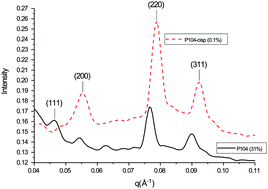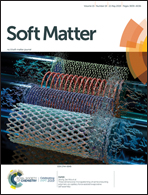The effect of cisplatin on the nanoscale structure of aqueous PEO–PPO–PEO micelles of varying hydrophilicity observed using SAXS
Abstract
Aqueous solutions of polyethylene oxide–polypropylene oxide–polyethylene oxide (PEO–PPO–PEO) copolymers form micelles and cubic lattices as their temperature is raised. The presence of added solutes within the dispersions can also affect the kinetics of structure formation. Here, we investigate the structures formed in the amphiphiles P104, P105, and F108 solutions at 31% mass per v both neat and co-formulated with the drug cisplatin (0.02% to 0.1% mass per v) using small-angle X-ray scattering. P104 formed BCC colloidal crystals while P105 and F108 formed FCC structures. Cisplatin had a minor influence of the formation and stability of the crystals during these thermal excursions. The largest interaction between the amphiphiles and cisplatin was P104 where there was a 2% reduction in the BCC lattice parameter of P104 as cisplatin loading rose to 0.1% at 28 °C. The F108 unit cell swelled ∼2% upon cisplatin loading of 0.1%. A progressive evolution and breakdown of these structures was noted as the temperature rose from 10 °C to 35 °C. For the different amphiphiles, crystal thermal expansion coefficients of ∼1 × 10−2 °C−1 were determined in neat and loaded amphiphiles with cisplatin and all the crystals swelled with increasing temperature.



 Please wait while we load your content...
Please wait while we load your content...
